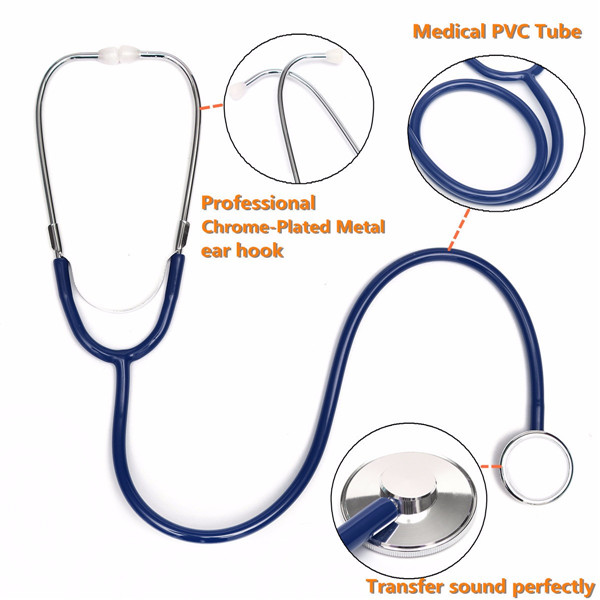Anatomy of a Stethoscope? What are parts of the stethoscope? how does stethoscope work?
 |
| Parts of stethoscope |
Parts of stethoscope:
Here are parts of stethoscope explained.
They come in different sizes and shapes to suit different preferences.
It is made of durable material that can withstand bending and folding without affecting sound transmission.
The length of the tubing affects how far you can stand from your patient while auscultating.
A longer tubing may reduce sound quality but increase mobility, while a shorter tubing may improve sound quality but limit mobility.
The chest piece:
The chest-piece is the part that contacts the patient's body. It has a stem that connects to the tubing and a diaphragm and/or a bell that transmits sound waves to the earpieces. The diaphragm is a thin membrane that vibrates when exposed to high-frequency sounds, such as heartbeats and breath sounds. The bell is a hollow cup that resonates with low-frequency sounds, such as murmurs and bruits. Some stethoscopes have a single-head design that can switch between diaphragm and bell modes by applying different pressure on the chest-piece. Others have a dual-head design that has both diaphragm and bell on opposite sides of the chest-piece.The headset:
The headset is the part that delivers sound to the user's ears. It consists of two eartubes, tension springs and eartips. The eartubes are metal rods that are angled to fit into the user's ear canals comfortably and securely. The tension springs are flexible wires that allow the user to adjust the pressure on their ears by squeezing or pulling apart the eartubes. The eartips are soft rubber or silicone caps that seal out external noise and enhance sound quality.They come in different sizes and shapes to suit different preferences.
The tubings:
The tubing is the part that connects the chest-piece to the headset.The length of the tubing affects how far you can stand from your patient while auscultating.
A longer tubing may reduce sound quality but increase mobility, while a shorter tubing may improve sound quality but limit mobility.
How does stethoscope work?
A stethoscope works by converting acoustic energy into mechanical energy and then into electrical energy. When sound waves hit the diaphragm or bell of the chest-piece, they cause it to vibrate.These vibrations are transmitted through air-filled columns in the lumen tubing to metal springs in the eartubes.
These springs amplify the vibrations and send them to magnets in the eartips. These magnets generate electric currents that stimulate the user's auditory nerves.
In this way if we listen to a person's heart we can hear a lub dub sound. Some stethoscope's have tunable diaphragms as well.
Know parts of steth
Importance of stethoscope?
A stethoscope is not only an instrument for diagnosis but also an expression of professionalism and identity for doctors and nurses. It is important to choose one that suits your needs, preferences and budget. You should also take care of your stethoscope by cleaning it regularly, storing it properly and replacing worn-out parts when necessary.Types of stethoscope?
There are many types of stethoscopes available in the market, each with its own advantages and disadvantages. Some common types are:
How to wear a stethoscope
Acoustic stethoscopes:
These are traditional stethoscopes that use air columns in tubes to transmit sound waves from chest-pieces to earpieces. They are simple, inexpensive and widely used, but they may have low sound quality, especially for low-frequency sounds.Electronic stethoscopes:
These are modern stethoscopes that use electronic circuits to amplify, filter and process sound waves from chest-pieces before sending them to earpieces or speakers. They have high sound quality, even for low-frequency sounds, but they may be expensive, complex and require batteries.How to wear a stethoscope
Digital stethoscopes:
These are advanced stethoscopes that use digital technology to convert sound waves from chest-pieces into digital signals before sending them to earpieces or computers. They can record, display and analyze sounds using software applications,but they may be costly, sophisticated and require compatible devices.
Fetal stethoscopes:
These are specialized stethoscopes that are designed to listen to fetal heart sounds during pregnancy. They have large bells or horns that can fit over pregnant women's abdomens, but they may be difficult to use, uncomfortable and inaccurate.
How does a stethoscope work
Doppler stethoscopes:
These are unique stethoscopes that use Doppler effect.Manufacturers of stethoscope:
Various companies make stethoscopes including 3m littmann, fricare, mdf, mccoy, alimed etc.How does a stethoscope work
Use of stethoscope:
- Measure blood pressure
- Hear lung sounds
- listen to heart sounds
- listen to bruits
- listen to other sounds in body
- listen to fetal heart sounds










What is your say on this?